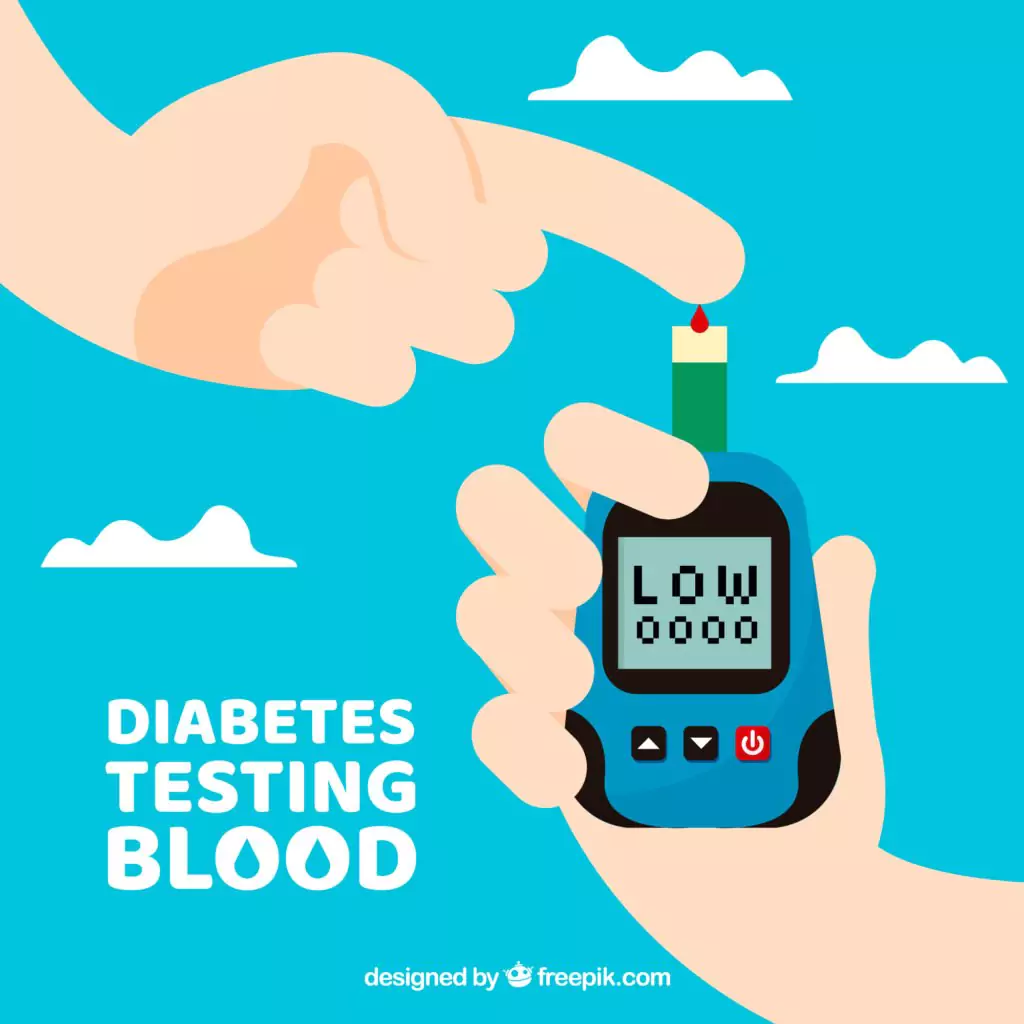






How to Recognize and Treat Diabetic Shock Symptoms


Table of Contents
- What Is Diabetic Shock?
- 10 Signs of Diabetic Shock
- Blurry Vision
- Headache
- Nervousness
- Dizziness
- Sweating
- Shakiness
- Anxiety
- Moodiness
- Hunger
- Convulsions
- How to treat diabetic shock symptoms
- 5 Foods for Low Blood Sugar
- 3 Best Supplements for Low Blood Sugar
- What Can I Do to Reduce the Risk of Developing Diabetic Shock?
- Conclusion
- About The Author
Diabetic shock is a serious health condition that can have severe and dangerous consequences if not treated properly and quickly. It is important to know the symptoms and signs of diabetic shock, and how to properly treat them. In this article, we will review what diabetic shock is, the symptoms of diabetic shock and how to treat it, as well as foods and supplements to reduce the risk of developing diabetic shock.
What Is Diabetic Shock?
Diabetic shock, also known as severe hypoglycemia, is a health emergency that requires immediate medical treatment. It often occurs in people with diabetes, typically when their blood sugar levels get too low. Without treatment, diabetic shock can lead to seizures, diabetic coma, and even death. The cause of diabetic shock is usually related to too much insulin, too little food, or additional stress on the body.
When the body fails to produce enough glucose for energy, it can develop a condition called hypoglycemia, which can cause a person to experience symptoms of diabetic shock. When someone is in diabetic shock, they often feel lightheaded, confused, dizzy, and have shakiness, a pounding heart, fast breathing, and sweating. They may experience hunger, blurred vision, difficulty speaking, and numbness or tingling in the fingers and hands.
It is important to seek medical help immediately if someone you know is displaying these symptoms. Treatment for diabetic shock includes a rapid injection of glucose, often through an IV, which will help bring the blood sugar level back to a safe level. Additionally, the patient should be monitored in a hospital to make sure their glucose levels remain at a safe level.
If the patient is alert, they may be given a sugary drink like orange juice to help raise the blood sugar level. For people with diabetes, it is important to monitor their blood sugar levels regularly to help prevent them from entering a state of diabetic shock. Additionally, they should always carry a source of quick-acting carbohydrates like a sugary drink or glucose tablets in case of an emergency.
In summary, diabetic shock is a serious medical condition caused by low blood sugar levels. It is important to recognize the symptoms of diabetic shock and seek medical help right away. Treatment for diabetic shock may include an IV injection of glucose and close monitoring in the hospital. To help prevent entering a state of diabetic shock, people with diabetes should monitor their blood sugar levels regularly and carry a source of quick-acting carbohydrates.
10 Signs of Diabetic Shock
It's important to recognize the signs and symptoms of diabetic shock and act swiftly. Therefore here are 10 symptoms of a diabetic shock to watch out for.
Blurry Vision
One of the most common symptoms of diabetic shock is blurry vision. It may be accompanied by other signs and symptoms such as weakness, intense thirst, headaches, dizziness, and nausea. Blurry vision is the most disabling symptom of diabetic shock and it can be a warning sign that you are having a diabetic episode. If you experience blurry vision, it is important to seek medical attention as soon as possible to get the proper treatment.
Blurry vision can be a symptom of diabetic shock because it can be caused by the sudden decrease of blood sugar levels in the body. This type of shock occurs when glucose levels fall too low, causing the body to be unable to use the energy it needs for proper functioning. When blood sugar levels decrease, the cells in the eye become less efficient at using the energy contained in glucose, causing blurry vision.
In addition, the blood vessels in the eye can become constricted, further impairing the ability to see clearly. It is also important to know the long-term effects of diabetic shock. If left untreated, long-term symptoms can include nerve damage, retinopathy, and an increased risk of developing further complications.
In order to reduce the risk of these long-term effects, it is important to get treatment as soon as possible. In conclusion, if you are experiencing blurry vision, it is important to seek medical attention as soon as possible. Blurry vision can be a symptom of diabetic shock, so it is important to be aware of the other symptoms of this condition, such as dizziness, nausea, and headaches.
Headache
Headaches are one of the common symptoms of diabetic shock, and it is important to recognize and treat them as soon as possible. Diabetic shock occurs when the body cannot produce and/or regulate insulin properly, resulting in dangerously low blood sugar levels. Headaches, in this instance, are typically severe and may worsen when standing from a sitting or lying position.
When it comes to treating headaches, it is important to quickly bring your blood sugar levels to back up to normal. You can do this by eating sugary snacks such as candy or juice or by taking an injection of rapid-acting insulin. Hypoglycemia unawareness can lead to major side effects. If your headache does not subside after 15 minutes, it is important to seek medical attention right away.
Nervousness
Nervousness is one of the most common physical symptoms of diabetic shock, which can be dangerous if left untreated. It is important for individuals with diabetes to be aware of the signs and symptoms of diabetic shock so that they can provide treatment when necessary. When a person experiences a sudden drop in their blood sugar, their body puts its 'fight or flight' response into effect.
This causes the release of hormones, such as adrenaline, which triggers the sympathetic nervous system. As a result, the person may experience nervousness, which typically manifests as trembling, sweating, a racing heart rate, or difficulty speaking and thinking. When a person experiences signs of nervousness, it is important to check their blood glucose levels right away.
If it is found that their levels have dropped, medical attention should be sought. Regardless of the treatment, it is important to note that diabetic shock can be life-threatening if left untreated. For individuals with diabetes, it is important to remain aware of the signs and symptoms of diabetic shock.
When treated early, symptoms of diabetic shock can be effectively managed. If you or someone you know experiences nervousness, it is important to check their blood glucose levels right away and seek medical attention if necessary.
Dizziness
One of the most common symptoms of diabetic shock is dizziness. Dizziness is a symptom of low blood glucose that can occur both when the blood sugar falls too low (hypoglycemia) or when there is a high blood glucose (hyperglycemia). When the body's blood sugar levels dip too low, the cells are not able to absorb enough glucose from the bloodstream.
This decrease in glucose causes feelings of dizziness and confusion. If the person is unable to respond, then they may experience a seizure, coma, or even death. Symptoms of hypoglycemia-related dizziness include confusion, weakness, irritability, trembling, palpitations, nausea, sweating, and headaches. Hyperglycemia, or high blood sugar, can also cause dizziness. The increased sugar overloads the cells, which leads to feelings of dizziness and disorientation.
Symptoms of hyperglycemia-related dizziness include feeling faint, blurred vision, drowsiness, and excessive thirst. If a person is experiencing any sign of diabetes shock, it is important to seek medical attention immediately.
Treatment depends on the type of diabetes shock and includes drinking sugary drinks and taking glucose tablets, eating a carbohydrate-rich snack, taking insulin, and sometimes an intravenous glucose solution. It is important to monitor one's blood sugar levels and stay informed about symptoms of diabetes shock in order to recognize and treat any episodes quickly.
Sweating
Sweating is one of the most common symptoms of diabetic shock, which is a medical emergency caused by low blood sugar. It is important to recognize the signs of diabetic shock in order to minimize the risk of serious complications. When faced with a diabetic shock, the body will naturally release hormones to try to address the low blood sugar levels. This can lead to excessive sweating, as the body tries to cool down the body and raise glucose levels.
If you notice that your loved one is sweating excessively, it may be a sign of diabetic shock. Alongside excessive sweating, other common symptoms of diabetic shock include sudden fatigue or confusion, pale or flushed skin, shaking, and rapid heartbeat. If any of these symptoms are present, it is important to get your loved one to the hospital immediately. When dealing with diabetic shock, it is important to act quickly to prevent the condition from worsening.
This means keeping the affected person in a comfortable and safe position and administering rapid-acting sugar if available. It is also important to monitor the glucose levels using a glucometer and to provide glucose tablets or other quick-release sugar sources. In some cases, intravenous glucose may be needed to raise blood sugar levels, so it is important to get medical attention quickly.
In conclusion, sweating is one of the most common symptoms of diabetic shock, and it is important to recognize the other signs of this condition to ensure that your loved one gets the necessary medical attention. It is also important to take immediate action to address the shock and raise the blood sugar levels so that further complications can be avoided.
Shakiness
People with diabetes are at risk of experiencing shakiness if their blood sugar drops significantly below normal levels, as this can cause their bodies to become weak and unsteady. The shakiness can range from mild trembling to more severe episodes of tremors. It can also be accompanied by other signs and symptoms such as confusion, anxiety, dizziness, sweating, chills, and pale skin.
It is important to recognize these signs so that they can be addressed promptly and the individual can be treated for diabetic shock. If you think someone is having a medically-induced episode of shakiness due to low blood sugar levels, it is essential to take immediate action.
The first step is to monitor the person’s symptoms closely and determine whether the shakiness is a result of a medical condition or not. If it is, you should administer a dose of glucose (in case of hypoglycemia) or insulin (in case of hyperglycemia) to bring their sugar levels back up to a safe range.
If the shakiness persists, it is important to seek medical attention immediately. At the hospital, the healthcare team will assess the individual’s condition and determine the best course of action. Treatment may include intravenous glucose, insulin, or both in order to rebuild the person’s glucose levels and restore their bodily functions.
If you think someone is experiencing a hypoglycemic episode, it is essential to take immediate action and get the necessary medical attention. By recognizing the signs and symptoms early, you can help to ensure the individual receives the treatment they need in order to recover from diabetic shock.
Anxiety
There are several things that can increase the risk of diabetic shock. These include physical activity, prolonged fasting, stress, excessive alcohol consumption, and certain medications. Additionally, having diabetes and being unaware of the symptoms of shock can increase the risk of developing diabetic shock. If you think you or someone you know is experiencing diabetic shock, it is important to seek medical help immediately.
The first step is to check the person’s blood glucose level. If it is low, they may need an emergency injection of glucose or a glucagon injection. If the person is unconscious, they may need to be given an intravenous infusion of glucose or dextrose. In addition to treatments that may be needed in emergency situations, there are a few lifestyle changes that can help people manage their diabetes and reduce their risk of diabetic shock.
For example, regularly monitoring and managing blood sugar levels, eating a balanced diet, and exercising regularly can help to maintain healthy and stable glucose levels. Additionally, it is important to be aware of how different activities can affect glucose levels and to take the necessary precautions, such as eating snacks or drinking glucose tablets, before engaging in those activities.
Diabetic shock can be serious and, in some cases, even life-threatening. It is important for those with diabetes to be aware of the symptoms of shock, know how to recognize it, and be prepared to seek medical help right away. With the right treatments and lifestyle changes, those with diabetes can help reduce their risk of diabetic shock and stay healthy.
Moodiness
Moodiness is a common symptom of Diabetic Shock and must be monitored closely to ensure the individual does not experience a more severe reaction. In most cases, moodiness is present in the early stages of Diabetic Shock and is the first sign of an impending emergency.
It is important for people who are diabetic to be aware that if they experience any of the following symptoms, they should seek medical attention as soon as possible:
• Increased irritability
• Feeling overwhelmed
• Difficulty concentrating
• Poor decision-making
• Poor judgment
• Feeling overwhelmed
• Anxiety
• Restlessness
If any of these symptoms are observed in someone who is diabetic, they should be monitored closely and medical advice should be sought immediately. If the individual is unable to seek medical help, family members should observe and document the person's behaviors and mood in order to provide medical personnel with a clear picture of what is happening. If a person with diabetes shows signs of diabetic shock, their blood sugar level should be tested immediately to determine if it is too low or too high.
Hunger
This occurs when the body does not have enough energy, so the brain signals the body to consume more food. Other symptoms of diabetic shock include confusion, dizziness, blurred vision, fatigue, nausea, palpitations, and cold sweats.
A person may also experience anxiety and difficulty breathing. If a person experiences any of these symptoms, they should immediately check their blood sugar levels. If the reading is lower than 70 milligrams per deciliter (mg/dl), they should take quick action.
A diabetic should have a quick-acting form of sugar, such as dextrose tablets or juice, on hand in order to raise their blood sugar quickly. If the person is too weak to take the sugar orally, medical assistance should be sought immediately.
Convulsions
Convulsions, or seizures, are one of the most serious symptoms of diabetic shock and must be treated promptly to avoid further health complications. These occur when the body's electrical system is disrupted. This often occurs when a person with diabetes experiences very high or low blood sugar levels. The typical symptoms of a seizure include involuntary muscle movements, such as muscle twitching, stiffening, trembling, and jerking.
Other signs may include confusion or loss of consciousness, along with irregular breathing and increased heart rate. If a person is having a convulsion, it is important to remain calm and take steps to protect the person from injury. Caregivers should remove any sharp or dangerous objects from the immediate area and move the person to a safe place.
It is important to protect the person's airway by gently turning the person onto their side so that any saliva can drain away. Caregivers should not attempt to give the person anything to eat or drink, as this could put the person at further risk of choking. Once the convulsions have stopped, the person should be monitored until their normal breathing has resumed. Medical attention should be sought as soon as possible.
How to treat diabetic shock symptoms
The first step in treating diabetic shock is to quickly increase the person's blood sugar level by giving them an emergency glucose injection. If the person is able, they can swallow a few glucose tablets or drink a few ounces of a glucose-containing beverage, such as orange juice.
If these remedies don't bring the blood sugar level up, the person must receive a glucagon injection, which will quickly raise the blood sugar level. If the person falls unconscious due to diabetic shock, a glucagon injection will still be necessary. However, you should also perform cardiopulmonary resuscitation (CPR) and call for emergency medical attention.
A glucagon injection will help to save the person's life, but only medical personnel can provide the proper medical attention. Diabetic shock can lead to permanent damage or even death if not treated quickly. It is important to recognize the signs and symptoms of diabetic shock so that you can take immediate action. If you think someone is in shock, it is important to get them the help they need right away.
5 Foods for Low Blood Sugar
One way to manage low blood sugar is to include certain nourishing foods in your diet. Keeping foods on hand that contain a combination of carbohydrates and proteins can help to raise your blood sugar levels, and provide the body with essential nutrients. Here are 5 foods to include in your diet if you are likely to experience episodes of low blood sugar:
Whole grain toast with peanut butter
The carbohydrates in the toast provide a quick energy boost, while the protein from the peanut butter helps to slow down the absorption of the sugar, so it is released into your bloodstream gradually.
Bananas
Bananas are a great choice for those with low blood sugar as they are full of fiber and vitamins, and also contain easily digestible carbohydrates.
Nuts
Nuts provide a steady source of energy and contain healthy fats, proteins and fiber. Opt for unsalted varieties such as almonds, walnuts and cashews.
Yogurt
Yogurt is a great source of protein and its high calcium content helps to keep blood sugar levels steady.
Berries
Many types of berries are packed with antioxidants and also contain a low-glycemic index, making them a great choice for those with low blood sugar. By ensuring that you have a variety of these foods available at all times, you can help to ensure that you are able to recognize and treat the symptoms of low blood sugar, and reduce your risk of experiencing diabetic shock.
3 Best Supplements for Low Blood Sugar
The three best supplements for controlling low blood sugar include chromium picolinate, berberine, and alpha-lipoic acid.
Chromium Picolinate
It is an essential trace mineral that plays a role in glucose metabolism. It helps the body better absorb glucose from food, which helps maintain healthy blood sugar levels. It can be taken as a supplement or found naturally in foods such as broccoli, eggs, and whole grains.
Berberine
It is an herbal extract found in plants such as barberry, goldenseal, and Oregon grape. Research has found that berberine helps to lower blood sugar levels by decreasing the amount of glucose absorbed in the body and increasing the effectiveness of insulin.
It is usually taken in capsule form or as part of an herbal tea or tincture. It is also available in SugarMD Super Berberine which not only helps in glucose metabolism but also reduces body inflammation.
Alpha-lipoic acid
It is an antioxidant that helps to regulate blood sugar levels. It can be found naturally in foods such as spinach, broccoli, and potatoes, and can also be taken as a supplement. Alpha-lipoic acid helps the body break down glucose into energy and can reduce the risk of nerve damage associated with diabetes. These three supplements can help to reduce the risk of diabetic shock and help people maintain healthy blood sugar levels.
What Can I Do to Reduce the Risk of Developing Diabetic Shock?
Let’s see how can you reduce the risk of developing diabetic shock: The first and most important step is to maintain a healthy diet and lifestyle. Eating a balanced diet that is low in sugar and fat, and high in fresh fruits and vegetables can help control your blood sugar levels. Additionally, engaging in regular physical activity, such as walking and swimming, can help you manage your diabetes.
It is important to always carry glucose tablets or gel in your pocket or bag so that if you experience a sudden drop in blood sugar, you can take a fast-acting sugar source to avoid hypoglycemia. It is also important to monitor your blood sugar levels regularly, especially if you are pregnant, have a history of low blood sugar, or take insulin. In addition to tracking your blood sugar, it is also recommended that you keep a close eye on your A1C levels.
This is important to ensure that you are able to detect any changes in your blood sugar levels and to adjust your dosage and medication accordingly. Finally, it is important to know the symptoms of shock and what to do if you experience them. Symptoms of shock include anxiety, dizziness, sweating, confusion, and fainting. If you experience any of these signs, seek medical attention immediately. By taking these precautions, you can help minimize the risk of having a life-threatening episode of diabetic shock.
Conclusion
In summary, recognizing and treating diabetic shock symptoms is very important in order to avoid serious health risks. Therefore, it is important to know the signs and symptoms of diabetic shock so that it can be treated as quickly and effectively as possible.
Furthermore, making sure to include the five foods and three best supplements for low blood sugar in your diet will help to reduce your risk of developing diabetic shock. With this knowledge, you can be prepared to handle diabetic shock symptoms in a professional and efficient manner.
About The Author
Who is Dr. Ergin? Dr. Ahmet Ergin is an endocrinologist interested in and passionate about diabetes care. Dr. Ergin earned his medical degree with honors at Marmara University School of Medicine in Istanbul, Turkey. Then, he completed his internal medicine residency and endocrinology fellowship at Cleveland Clinic in Cleveland, Ohio.
He is a board-certified Internal Medicine and Endocrinology, diabetes, and metabolism physician. He is also a certified diabetes education specialist. Disclaimer: Any information on diseases and treatments on this website is for general guidance only. It must never be a substitute for the advice your doctor or other qualified healthcare professional provides. Always seek the advice of your physician or other qualified healthcare professional’s advice with questions regarding your medical condition.
Written By Dr. Ahmet Ergin
456 total articles
Meet Dr. Ahmet Ergin, a highly skilled and dedicated endocrinologist with a passion for diabetes care. Dr. Ergin earned his medical degree with honors from Marmara University in Istanbul. He completed internal medicine residency and endocrinology fellowship at Cleveland Clinic. Dr. Ergin is board-certified in Internal Medicine, Endocrinology, Diabetes, and Metabolism due to his vast medical expertise. He's a certified diabetes educator, author of “The Ultimate Diabetes Book,” and founder of “the SugarMD YouTube channel.” Dr. Ergin offers exceptional diabetes care to his patients in Port Saint Lucie, FL, helping them manage effectively. For a closer look into his insights and experiences, connect with Dr. Ahmet Ergin on LinkedIn, Instagram, and YouTube.”
Disclaimer: These statements have not been evaluated by the Food and Drug Administration. Information on this website isn't intended to treat, cure or prevent any disease. Discuss with your doctor and do not self-treat.
Products











